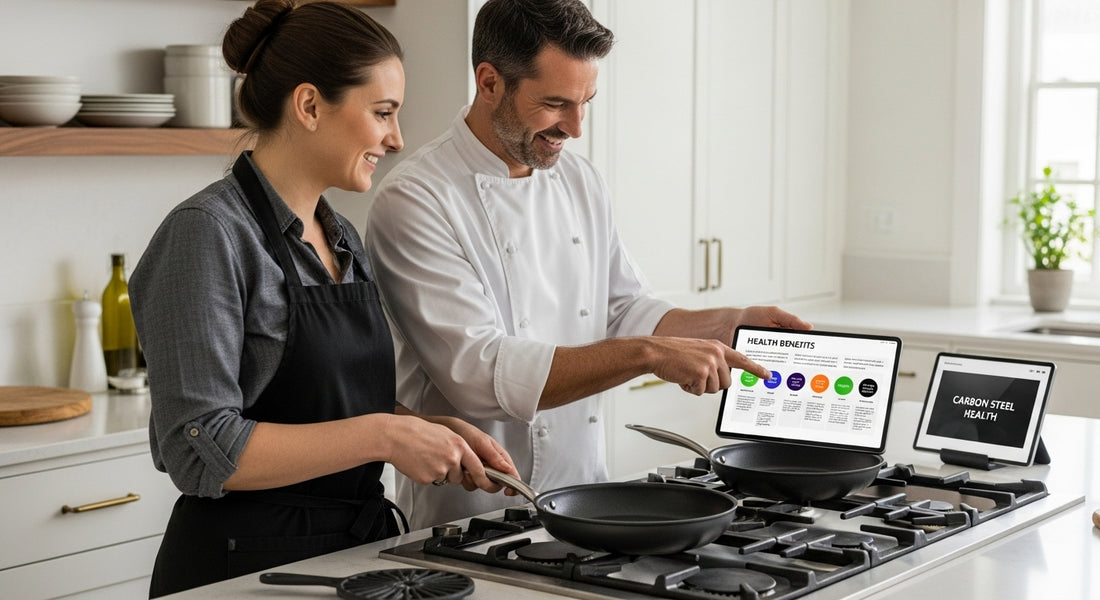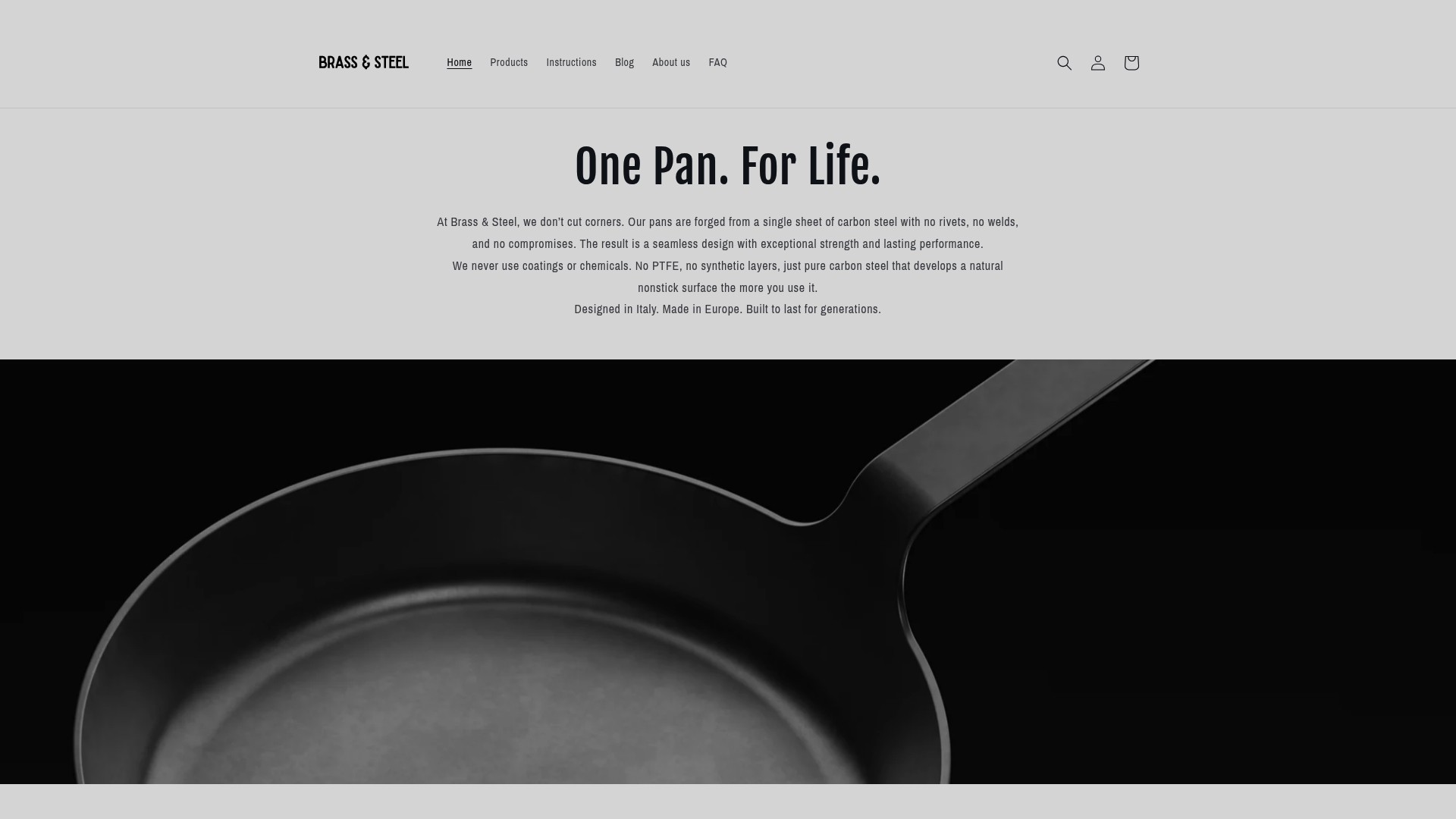
Understanding the Carbon Steel Health Benefits Guide
Share
Carbon steel is everywhere, from industrial machinery to the chef’s favourite frying pan. Most people know it’s just iron mixed with carbon, right? Yet the magic lies in the numbers. That carbon content can be as little as 0.05% or as much as 2.0% by weight—and this tiny difference completely transforms its properties and uses. So the real surprise is how one metal, with a fraction more carbon, can go from bendy and soft to tougher than nails without changing anything else.
Table of Contents
- What Is Carbon Steel And Its Composition?
- Why Choose Carbon Steel For Cooking?
- How Carbon Steel Affects Food Preparation
- Health Benefits Of Cooking With Carbon Steel
- Real-World Applications Of Carbon Steel In Kitchens
Quick Summary
| Takeaway | Explanation |
|---|---|
| Carbon steel offers exceptional heat conductivity. | Its rapid and even heat distribution allows for precise temperature control in cooking, enhancing culinary results. |
| Carbon steel develops a nonstick surface through seasoning. | Unlike synthetic coatings, this process creates a natural patina that improves cooking performance over time. |
| Cooking with carbon steel can enhance nutritional intake. | Trace amounts of iron are transferred to food, benefiting those with iron deficiencies, while maintaining food quality. |
| Carbon steel cookware is highly durable and sustainable. | With proper care, these pans can last generations, reducing waste compared to single-use cookware. |
| Suitable for diverse cooking techniques and environments. | From home kitchens to professional settings, carbon steel adapts effectively across various cooking methods and heat sources. |
What is Carbon Steel and Its Composition?
Carbon steel represents a fundamental material in metallurgy and manufacturing, characterized by its unique blend of iron and carbon. Carbon steel composition fundamentally differs from other steel types through its carbon content, which typically ranges between 0.05% and 2.0% by weight.
Understanding Carbon Content Variations
Carbon steel is not a uniform material but encompasses several subcategories based on carbon concentration. These variations significantly influence the metal’s mechanical properties and potential applications:
- Low-carbon steel: Contains up to 0.3% carbon
- Medium-carbon steel: Contains between 0.3% and 0.6% carbon
- High-carbon steel: Contains between 0.6% and 2.0% carbon
Each category offers distinct characteristics. Low-carbon steel provides excellent ductility and is easily formable, making it ideal for general manufacturing.
![]() Medium-carbon steel balances strength and flexibility, while high-carbon steel delivers superior hardness and wear resistance.
Medium-carbon steel balances strength and flexibility, while high-carbon steel delivers superior hardness and wear resistance.
Culinary Applications and Material Properties
In cookware, carbon steel’s composition makes it particularly attractive. The material combines lightweight properties with exceptional heat conductivity and durability. Chefs and home cooks appreciate carbon steel for its natural nonstick surface that develops through seasoning. Read more about carbon steel maintenance to understand how this unique material performs in kitchen environments.
The iron and carbon atoms in carbon steel create a crystalline structure that allows for remarkable thermal transfer and even heat distribution. This molecular arrangement explains why professional kitchens frequently choose carbon steel cookware for precise temperature control and consistent cooking results.
Understanding carbon steel’s composition helps appreciate its versatility across industries from culinary arts to industrial manufacturing. Its adaptable nature stems directly from its fundamental chemical structure and carefully balanced carbon content.
The following table summarises the key characteristics of low, medium, and high-carbon steel, clarifying how carbon content directly impacts their properties and typical uses.
| Carbon Steel Category | Carbon Content Range | Key Properties | Typical Applications |
|---|---|---|---|
| Low-carbon steel | Up to 0.3% | Excellent ductility, easily formed | General manufacturing, cookware |
| Medium-carbon steel | 0.3% – 0.6% | Balance of strength and flexibility | Structural components, cookware |
| High-carbon steel | 0.6% – 2.0% | Superior hardness, wear resistance | Cutting tools, high-performance pans |
Why Choose Carbon Steel for Cooking?
Carbon steel emerges as an exceptional cookware material, offering professional chefs and home cooks a versatile and high-performance cooking solution. Scientific research on cookware materials highlights carbon steel’s unique properties that make it superior to many traditional cooking surfaces.
Superior Heat Performance and Responsiveness
One of carbon steel’s most compelling attributes is its extraordinary heat conductivity. Unlike other materials that struggle with temperature control, carbon steel provides rapid and even heat distribution. This means:
- Faster heating times
- More precise temperature management
- Reduced risk of hot spots and uneven cooking
- Excellent searing capabilities for meats and vegetables
Professional kitchens value these characteristics because they translate directly into consistently excellent culinary results. The material’s ability to quickly adjust to temperature changes allows chefs to respond instantaneously during complex cooking techniques.
Natural Nonstick Properties and Health Considerations
Carbon steel develops a natural nonstick surface through a process called seasoning, which distinguishes it from synthetic nonstick cookware. Explore our detailed guide on carbon steel maintenance to understand how this unique surface evolves.
Unlike traditional nonstick pans that rely on chemical coatings, carbon steel creates a protective patina through repeated cooking. This patina not only prevents food from sticking but also enhances the pan’s natural flavour-developing properties. Health-conscious cooks appreciate that this process occurs without introducing potentially harmful synthetic chemicals.
Additionally, carbon steel cookware offers remarkable durability. With proper care, these pans can last generations, making them an environmentally sustainable choice compared to disposable cookware that requires frequent replacement. Their robust construction means they can transition seamlessly from stovetop to oven, providing unparalleled versatility in the kitchen.
This table compares carbon steel cookware with traditional synthetic nonstick pans, highlighting the differences in health, performance, and durability aspects referenced throughout the guide.
| Feature | Carbon Steel Cookware | Synthetic Nonstick Cookware |
|---|---|---|
| Nonstick Surface Origin | Developed through seasoning | Chemical coating (PTFE, PFOA) |
| Chemical Exposure Risk | None | Potential at high temperatures |
| Heat Tolerance | Very high | Limited (can degrade) |
| Durability | Highly durable, long-lasting | Often requires replacement |
| Iron Transfer | Minimal dietary benefit | None |
| Environmental Impact | Sustainable, reusable | Increased waste from replacements |

How Carbon Steel Affects Food Preparation
Carbon steel presents a transformative approach to food preparation, influencing cooking techniques through its unique material properties. Culinary research on cookware interactions demonstrates how the material fundamentally changes cooking dynamics and flavour development.
Flavour Enhancement and Molecular Interactions
The carbon steel surface interacts dynamically with ingredients, creating complex flavour profiles that distinguish it from other cookware materials. When heated, the pan’s seasoned surface releases subtle molecular compounds that gently infuse foods with nuanced taste characteristics. This interaction occurs through:
- Gradual fat polymerization
- Maillard reaction acceleration
- Microscopic surface texture development
- Minimal metallic ion transfer
Professional chefs appreciate how carbon steel develops a natural seasoning that becomes increasingly sophisticated with repeated use, creating a cooking surface that actually improves over time.
Precise Temperature Control and Cooking Techniques
Carbon steel’s extraordinary thermal responsiveness enables unprecedented cooking precision. The material rapidly adjusts to temperature changes, allowing chefs to execute complex techniques like searing, deglazing, and quick temperature transitions. Learn more about managing cooking techniques with carbon steel to understand its full potential.
The pan’s heat distribution ensures uniform cooking temperatures, preventing hot spots that can unevenly cook ingredients. This characteristic is particularly crucial for delicate proteins, vegetables, and techniques requiring exact thermal management.
Moreover, carbon steel’s ability to withstand high temperatures makes it ideal for methods ranging from stovetop searing to oven finishing. Its versatility allows seamless transitions between cooking stages, giving chefs unprecedented control over culinary outcomes.
Health Benefits of Cooking with Carbon Steel
Carbon steel emerges as a superior cookware choice that offers significant health advantages beyond traditional cooking surfaces. Research on cookware safety and health impacts highlights the material’s unique properties that contribute to healthier cooking practices.
Chemical-Free Cooking Surface
Unlike synthetic nonstick cookware, carbon steel provides a completely natural cooking surface that develops without harmful chemical coatings. The pan’s seasoning process creates a protective layer through natural polymerization, which means:
- Zero synthetic chemical migrations
- No PFOA or PTFE exposure
- Gradual development of a naturally nonstick surface
- Minimal risk of toxic compound release
Health-conscious individuals appreciate that carbon steel eliminates potential risks associated with traditional nonstick technologies, which can degrade at high temperatures and potentially release harmful substances.
Nutritional Enhancement and Mineral Transfer
Carbon steel uniquely contributes to nutritional intake through minimal iron supplementation during cooking. As the seasoned surface interacts with food, trace amounts of dietary iron are gently transferred, potentially supporting individuals with iron deficiencies. Learn more about managing cookware interactions to understand these subtle nutritional dynamics.
The pan’s natural seasoning also prevents excessive metallic interactions, ensuring that mineral transfer remains balanced and beneficial. This characteristic distinguishes carbon steel from other reactive cookware materials that might compromise food quality or introduce unwanted metallic tastes.
Moreover, the material’s ability to cook at precise temperatures helps preserve nutritional content, reducing the likelihood of nutrient degradation through excessive heat or prolonged cooking processes. Professional nutritionists recognize this as a significant advantage in maintaining the intrinsic health benefits of ingredients.
Real-World Applications of Carbon Steel in Kitchens
Carbon steel transcends theoretical potential, proving itself as a versatile and indispensable material across diverse culinary environments. Professional kitchen equipment research demonstrates its remarkable adaptability in professional and home cooking settings.
Professional Culinary Environments
In professional kitchens, carbon steel represents a fundamental tool that meets demanding performance requirements. Chefs rely on its exceptional characteristics for complex cooking techniques that require precision and consistency:
- Rapid temperature responsiveness
- Exceptional heat distribution
- Durability under intense cooking conditions
- Seamless transition between cooking methods
Commercial kitchens particularly appreciate carbon steel’s ability to withstand continuous usage without performance degradation. Restaurant environments demand cookware that can endure high-stress cooking scenarios while maintaining optimal culinary outcomes.
Versatile Home Cooking Applications
Home cooks increasingly recognise carbon steel’s transformative potential beyond traditional cookware limitations. Explore the nuanced differences between cooking materials to understand its unique advantages.
Carbon steel adapts effortlessly across various cooking techniques including searing, sautéing, roasting, and even baking. Its multifunctional nature means a single pan can replace multiple kitchen tools, offering home cooks an efficient and space-saving solution.
The material’s compatibility with multiple heat sources further enhances its appeal. Whether using gas, electric, induction, or outdoor cooking platforms, carbon steel performs consistently, providing home cooks with unprecedented cooking flexibility. Professional chefs and home cooking enthusiasts alike appreciate its ability to develop a naturally nonstick surface through seasoning, creating a cooking experience that improves with each use.
Experience the Real Health Benefits of Carbon Steel Today
If you are searching for safe, chemical-free cooking and real control over your kitchen health, discover the difference a genuine carbon steel pan can make. Unlike ordinary cookware, our carbon steel products from Brass & Steel are crafted for health-conscious cooks who want natural nonstick performance without exposure to PTFE or PFOA. The single-piece construction and responsive heating enable effortless seasoning, ensuring that every meal benefits from a pure, protective patina and enhanced nutritional value.

Do not compromise your wellbeing or your food’s flavour. Explore our Carbon Steel Collection to find the sauté pan that fits your needs. Visit Brass & Steel’s main site and see why chefs and passionate home cooks across Europe are making the healthy switch right now. Your next step to cooking with confidence and clarity begins here.
Frequently Asked Questions
What are the health benefits of using carbon steel cookware?
Carbon steel cookware is free from harmful chemical coatings, providing a natural cooking surface. It allows for chemical-free cooking, minimising the risk of toxic substances mingling with food.
How does carbon steel enhance nutritional value during cooking?
Cooking with carbon steel can lead to minimal iron transfer into food, potentially benefiting individuals with iron deficiencies. This natural mineral content can enhance nutritional intake while cooking.
Is carbon steel cookware safe at high temperatures?
Yes, carbon steel cookware is safe for high-temperature cooking. Unlike synthetic nonstick pans, carbon steel does not degrade or release harmful substances when exposed to high heat.
How do I maintain and season carbon steel cookware for optimal health benefits?
Maintaining carbon steel cookware involves regular seasoning, which creates a nonstick layer through natural polymerisation. This protective layer improves over time with use, ensuring a safe and effective cooking surface.
Recommended
- What is Carbon Steel Maintenance? Understanding its Importance – Brass & Steel
- Understanding Cooking Acidic Foods in Carbon Steel – Brass & Steel
- Health & Safety Benefits of Carbon Steel Pans – Brass & Steel
- Understanding Iron vs Carbon Steel for Culinary Use – Brass & Steel
- Key Benefits of Carbon Steel for Industrial Projects - Genesis Steel